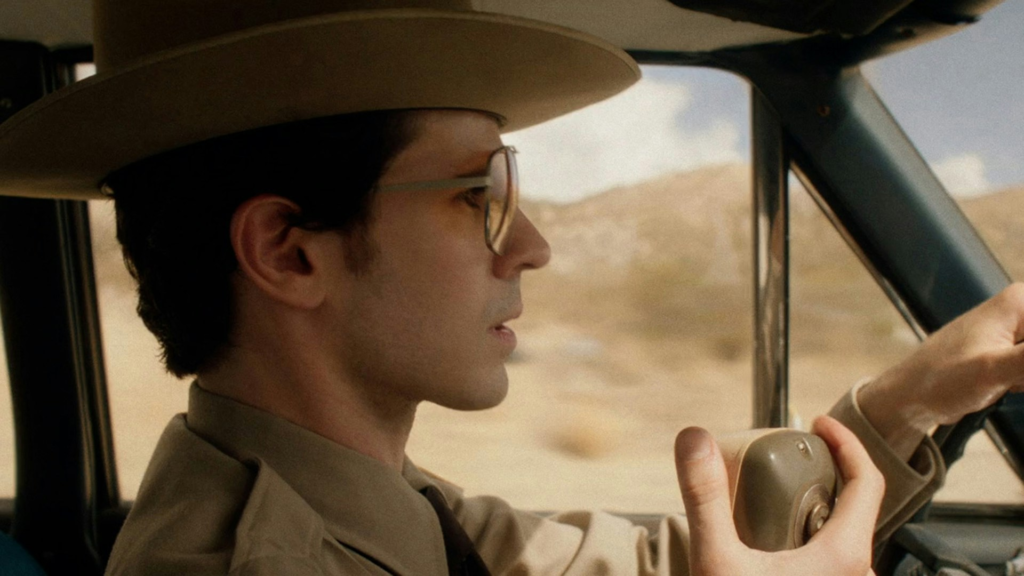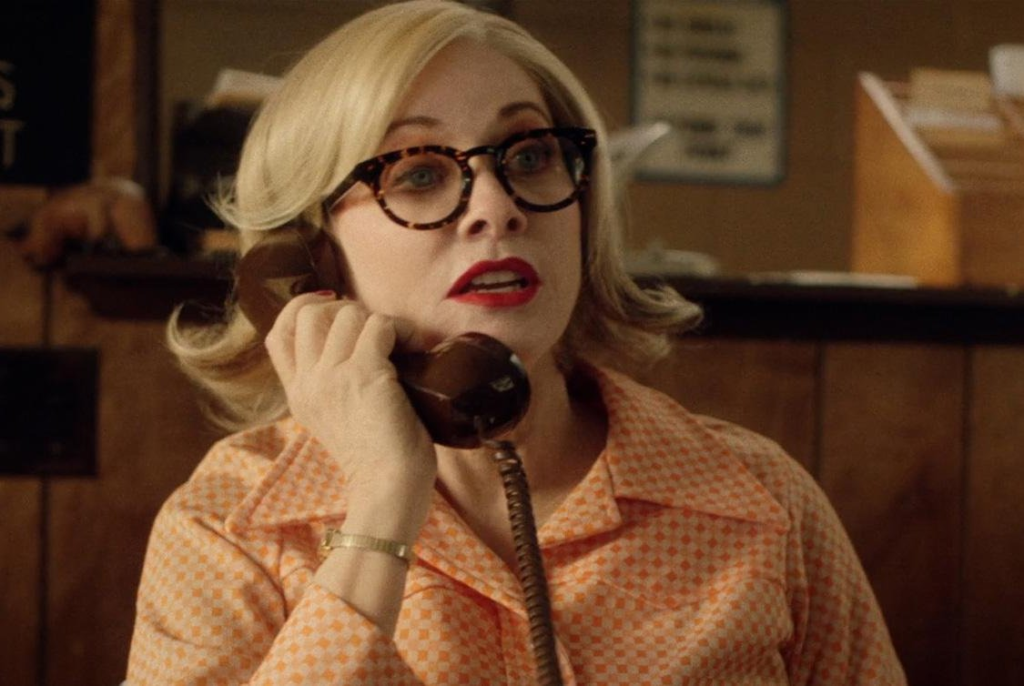Breaking News with Francis Galluppi! The Last Stop in Yuma County is on its way!
Francis Galluppi is the kind of cinema freak wunderkind audiences adore. He’s funny, humble, and just wants to share all his abundant passion for movies.
Galluppi’s debut feature, The Last Stop in Yuma County, gives Quentin Tarantino a run for his money with homages to genre cinema wrapped up in a delectable package. A tight and darkly comic script leans into visual cues that are familiar but reconfigured to provide maximum bang for your buck. Even better, it isn’t at all pretentious.
Nadine Whitney chatted to Francis before the debut of his film last year at Fantastic Fest in Austin, Texas.
To give the reader an idea of who Francis Galluppi is there were several places where the asides began to overrun the interview such as the mutual appreciation of Francis’ Hausu t-shirt. “That shit is wild! I fucking love that movie!” he says. Nadine laughs about how it was originally pitched as a Jaws rip-off, but Obayashi let his young daughter shape the narrative… and voila! School girls, a house that eats them, a wicked witch, a weirdo cat. Sometimes, it is good to let your kids do your homework for you.
The synopsis for Last Stop in Yuma County is: While stranded at a rural Arizona rest stop, a traveling salesman is thrust into a dire hostage situation by the arrival of two bank robbers with no qualms about using cruelty-or cold, hard steel-to protect their bloodstained fortune.

Nadine Whitney: The Last Stop in Yuma County is your first feature, but you’ve done shorts. How did you get the production off the ground?
Francis Galluppi: Oh, wow… that’s a long story. The short version is that one of my shorts played in Cincinnati in 2018 or 19 and I met James Claeys, the executive producer, there. Basically, he offered me $50,000 to make a feature. So, I was trying to write something really contained in a single room. But obviously it needed more than $50,000. I thought oh shit, we can’t do this for that little. The script went through different variations and, in the end, James ended up selling his house to finance the movie.
We did it completely independently. It was just James and me there so nobody was looking over our shoulders to tell us what to do. We were on our own and it gave us a lot of freedom, but we were also really, really, lucky to end up with what we made.
NW: It’s a great movie and I have to say I laughed so much. Please tell me I am allowed to find it funny considering the scorched earth nature of the film.
FG: Yes! You finding it funny makes me so happy. I’m terrified that people aren’t gonna find the humor in this movie as I’m constantly pitching it as a dark comedy and I’m hoping people get that.
NW: It is ultra-violent, but I was cackling through it. The little off hand references such as “My grandson just moved to Waco to start a ministry.” Miles and Sybil thinking they are a version of Bonnie and Clyde or Charles Starkweather and Caril Ann Fugit with Miles styled as Martin Sheen in Badlands. Plus, genius casting to have Jim Cummings as the star because he is a comedian and he’s done his own horror/genre work.
Which brings me to the cast, which is a smorgasbord of genre icons. You’ve got Barbara Crampton, Alex Essoe, Gene Jones, Richard Brake, and Jocelin Donahue. How did you get those people on board?
FG: I got incredibly lucky. I’ve been a huge fan of every single one of these actors for the longest time. They really were my dream cast. A lot of the actors I already had in mind when I was writing the characters. I had an amazing casting director, David Guglielmo.
I wrote them all personal letters and, thankfully, they read them, and we jumped on Zoom and somehow, we convinced them to do the movie. First, we got five and I was like holy shit like this is crazy. Maybe we can keep it going further. I thought there was no way Barbara Crampton is going to just play a receptionist, but we talked, she looked at the script, and committed to it. Every time we kept stacking another name on there it was like surreal, because, like I said, I just am a huge fan so there wasn’t a single person in the movie that I didn’t already love. With Jocelin, I think the first time we jumped on a zoom I pulled out my House of the Devil merch and showed her that I had it. I embarrassed myself a little bit.

NW: They are all pitch perfect – one of my favorite pieces of casting is Connor Paolo as the mostly clueless cop, Gavin. I swear Connor hasn’t aged a day since Gossip Girl. I also did a double take when I saw Sierra McCormick as Sybil.
FG: I saw that switchboard scene in The Vast of Night I was like this girl is incredible! I wrote a letter to her asking her to play Sybil. Sierra asked me, “Why did you think I could play this character it’s like night and day from Fay in The Vast of Night.” I said if you can do what you did in that film it means you can do fucking anything! Just amazing.
NW: The film is shooting across so many genres it’s dizzying. It’s intense, funny, and self-aware as a moral quandary crime-doesn’t-pay narratives that hits the mark.
FG: I wanted to do my version of the neo-noir slash western. For me, it is a neo-noir but in the daylight. A lot of people didn’t see how it could be noir – but noir is about more than an aesthetic, it is a storytelling tool with loads of ideas which fit into it. Purists might disagree.
NW: Purists would be wrong! Noir isn’t just a gumshoe and femme fatale template. Kathryn Bigelow made a vampire-western-neo-noir with Near Dark. There are science fiction noirs. The wonderful thing about storytelling is the process of creating a mashup to give people recognisable motifs that draw them in to a bigger narrative.
The Last Stop at Yuma County finds the sweet spot where it is a bit meta, but it’s also its own thing. It’s not a copy paste job at all, more an exuberant “We all dig this stuff, yeah?!”
FG: I adore ’70s cinema too, and the movie was sort of my love letter to Don Seigel and Sam Peckinpah. There are heaps of little references like where Miles talks to Sybil about his idea for a heist which he stole from Rififi, which is one of my favorite movies. They also discuss Badlands and Bonnie and Clyde. I just threw together some of my most cherished movies into the mix.
NW: I wanted to talk to you was about the shooting process. You have single location work (mostly in and around the diner and gas station) but there are some other set pieces that are quite expansive.
FG: We had a twenty-day shooting schedule, so it was really tight. Plus, we were in the desert, so the weather was just completely unpredictable. There were days where it was just squalls and rainstorms and our equipment was blowing over and we had to pivot.
I work really closely with Max Fisken, my cinematographer, and we prepped extensively. We had the shot design and a shot list we had photo boarded previously. Every day we got something because it was planned. We’d be ready to do an A shot or a B shot at short notice and move between locations. Nothing could be left on the cutting room floor ’cause every shot was necessary. You need at least an hour to plan a lot of scenes but with the time and budget restraints, we couldn’t fuck around. We had to find and take advantage of every moment. But the cast and crew were amazing and synced with the timing we committed to. We always had to work precisely because everyone was ready to go and use the daylight to our advantage thankfully it was mainly a little easier to get everything.

NW: The film looks slick and more expensive than it was. There are some incredibly smooth shots like what I was calling “low car cam” where the camera was moving in tandem with all the classic cars – bumper cam where it closes in on a car reversing and moves with it. You made reversing or parking a car suspenseful.
The way you build the film is brilliant. You front load so many clues and cues which lead to great pay offs. You also do some classic misdirection. Because of the diner setting being somewhat static, where you point the camera is what immerses the audience. Often you follow eyeline POV for the characters as they try to silently communicate and other times you have the “Hitchcock pact” where the audience knows more than the characters because they have seen more.
The movie is set in 1981 but it has that time stopped still feeling where it could be much earlier because the diner itself is already antiquated.
FG: It is supposed to have that vibe. You only get a specific date a couple of times. If you look at the newspaper closely or notice things like Earline and Robert’s comment about Waco. That was an easter egg because 1981 was when Vernon (aka David Koresh) moved in with the Branch Davidians. I wondered if I could get away with some of the things I put in the script.
NW: Francis, you get away with it because it’s all done so brilliantly. The whole package is top notch. You have created a certified masterstroke as your first feature. It’s pulpy but intelligent. It’s hilarious but also has emotional gravitas. You know the rules of the game so you can break them. I was sold within the first five minutes with the establishing shots and the first joke. I haven’t even mentioned the best part… but that’s something other people can experience.
I’ve done enough selling now it’s your turn.
Why should people see The Last Stop in Yuma County?
FG: I’m a bad salesman, but I’ll try.
The Last Stop in Yuma County is a fucking blast. It’s so much fun. If you want to see violence and comedy and just go on a fun ride with a bunch of fantastic actors that you’re gonna fucking love.





